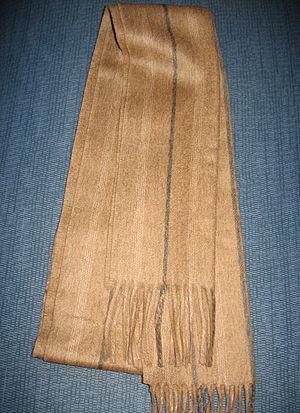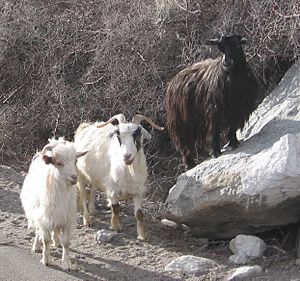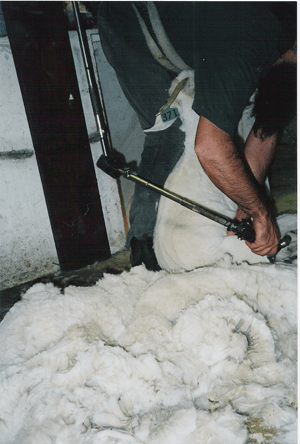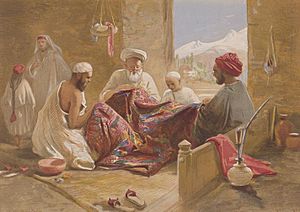Cashmere wool facts for kids
Cashmere wool, often just called cashmere, is a super soft and warm fiber. It comes from special goats, mainly cashmere goats. People often think of it as a type of wool, but it's much finer and softer than regular sheep wool. It's also very light and strong. Clothes made from cashmere are excellent at keeping you warm, about three times better than sheep's wool!
The name cashmere comes from the Kashmir region in India, where it has been made for a very long time. In the United States, there are rules about what can be called cashmere. For example, it must be the fine, soft undercoat from a cashmere goat. Also, the fibers must be very thin, usually less than 19 microns wide. (A micron is a tiny unit of measurement!)
Cashmere fiber comes from the neck area of cashmere goats. These goats have a special double coat. They have a fine, soft undercoat (the cashmere) and a coarser outer coat called guard hair. To get the soft cashmere, the guard hairs must be removed. This is done using a mechanical process called de-hairing. After de-hairing, the clean cashmere is ready to be dyed and made into yarn, fabrics, and clothes.
Contents
How Cashmere is Gathered
Cashmere is collected in the spring when goats naturally shed their winter coats. This usually happens between March and May in the Northern Hemisphere.
There are a few ways to collect the fiber:
- Combing: In some places, like America, people use a coarse comb to gently pull tufts of fiber from the goat's coat by hand. This method gives a higher amount of pure cashmere after cleaning. It can take about a week or two to comb a goat.
- Shearing: In other regions, like Iran, Afghanistan, New Zealand, and Australia, goats are shorn (their fleece is cut off). This method collects more of the coarse guard hairs, so it needs more processing later to separate the fine cashmere.
The long, coarse guard hairs that are removed are not wasted. They are often used to make things like brushes or other non-clothing items.
Where Cashmere is Produced
China is the biggest producer of raw cashmere today. They produce about 10,000 metric tons each year. Mongolia is the second largest producer. Other countries like Afghanistan, Iran, and Turkey also produce cashmere.
Globally, about 15,000 to 20,000 tons of raw cashmere (with hair) are produced each year. After cleaning and removing the coarse hairs, the amount of "pure cashmere" is much less, around 6,500 tons.
Very fine cashmere, also known as Pashmina, is still made by communities in Indian Kashmir. However, it's rare and expensive. On average, one goat produces about 150 grams (a little over 5 ounces) of pure cashmere each year.
Pure cashmere can be dyed and spun into soft yarns. These yarns are then used to make many different items, such as:
Countries like Scotland, Italy, and Japan are well-known for making high-quality cashmere fabrics and clothes.
Different Types of Cashmere Fiber
Cashmere fiber can be described in different ways based on how it has been processed:
- Raw: This is the fiber exactly as it comes off the animal, before any cleaning or processing.
- Processed: This fiber has been cleaned, de-haired, and prepared. It's ready to be spun into yarn or used for knitting or weaving.
- Virgin: This means it's new fiber that is being made into yarn, fabric, or clothing for the very first time.
- Recycled: This fiber comes from old cashmere scraps or fabrics that were previously used. It's reclaimed and reused.
A Brief History of Cashmere

Cashmere has been made in places like Mongolia, Nepal, and Kashmir for thousands of years. Famous jamawar shawls with their unique paisley patterns were made from this fiber. The fiber is also known as pashm (which means 'wool' in Persian) or pashmina.
Many people believe the cashmere wool industry in Kashmir was started by a ruler named Zain-ul-Abidin in the 15th century. He brought weavers from Turkestan to Kashmir. Another idea is that cashmere crafts were introduced by Mir Sayyid Ali Hamadani in the 14th century. He brought 700 craftsmen from Persia to Kashmir. When he visited Ladakh, where cashmere goats live, he saw how soft their wool was. He suggested starting a shawl-making industry in Kashmir using this special wool.
Cashmere shawls became popular in Europe in the late 1700s and early 1800s. A French general sent one to Paris, and people loved it! This led to efforts to start making cashmere products in France and Scotland.
In the early 1800s, people even tried to bring cashmere goats to Europe to produce the fiber there. For example, William-Louis Ternaux in France tried to set up herds of cashmere goats. Some goats were brought from Persia to France, and then some were even sent to England and Australia.
In Scotland, making cashmere shawls became a big industry by the 1830s. A reward was even offered to the first person who could spin cashmere in Scotland using the French methods.
Later, in 1890, a company called Dawson International invented the first machine to de-hair cashmere commercially. This made it easier to process large amounts of cashmere.
In the United States, the town of Uxbridge, Massachusetts became an important center for the cashmere wool industry during the American Industrial Revolution.
Bernhard Altmann, an Austrian textile maker, is known for bringing cashmere to the United States on a large scale starting in 1947.
Images for kids
See also
 In Spanish: Cachemira (fibra) para niños
In Spanish: Cachemira (fibra) para niños






